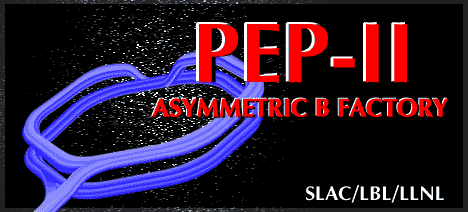 01/03/00 Update
01/03/00 Update  01/03/00 Update
01/03/00 Update PEP-II Update January 3, 2000
Summary of the PEP-II fall 1999 run:
BaBar had a two week down in October to install the remainder of its DIRC bar boxes. PEP-II recovered beams about October 18 and e+e- collisions were restored in the following week. The primary purpose of the fall run was to integrate luminosity for BaBar. The run was going well until November 13 when a vacuum leak opened on a synchrotron radiation mask in the interaction region in the HER. This leak as fixed but opened again a few days later and again fixed. A few days after that, a second vacuum leak developed in another IR mask with a similar design. The problem was stress fatigue in a stainless weld after 1000 heating cycles. Therefore, it was determined that the construction of these masks (three total in PEP-II) was not adequate. A decision was made to remove these chambers and rework them starting in December. A twelve day machine development period in late November was planned to allow preparation time for repairing the chambers and to allow studies of low currents in the HER and high currents in the LER. PEP-II was turned off on November 29. These chambers will be reinstalled by about January 12, 2000, when PEP-II will return to collisions. The plan is to run constantly through July 31, 2000.
Collision summary:
After a brief machine development period in October, PEP-II settled into a luminosity integration mode for BaBar. The luminosity of September was restored quickly and a luminosity of 1.4x10**33/cm**2/s was passed on November 7, 1999. Our present record luminosity of 1.43x10**33/cm**2/s was achieved on November 10 where 830 bunches were collided with 908 mA of positrons, 642 mA of electrons and a specific luminosity of 2.0. The cap-sigma spot sizes were about 6.5 and 200 microns vertically and horizontally, respectively. Note the current ratio is 1.4 e+ to e- whereas the design is 3.0. The beam-beam tune shifts are about 0.035 horizontally and 0.02 vertically.
During the time between the two separate vacuum leaks, PEP-II collided with
fewer bunches to not over heat the HER chamber mask. During that time a
luminosity of 1.03x10**33 was reached with 415 bunches and 800 mA e+ on 305 mA
of e-. The current ratio was 2.6 which is much closer to the design. Why the
optimum current ratio varies with time is not known. During the fall run PEP-II
delivered about 0.5 fb**-1 to BaBar bringing the total to about 2.0 fb**-1, with
1.8fb**-1 on the peak of the Upsilon 4S and 0.2 fb**-1 off the resonance.
Radiation bursts which last for a short time (1 sec) continue to dominate the
beam aborts during the colliding coasts. RF system trips are the second largest
cause of aborts. There are about thirty aborts per day.
Machine development results:
The LER positron current was raised to a new record of 1.72 A in 1658 bunches. The beam was stable at this current although the RF system needed some adjustments.
The beams at the interaction point were measured to be tilted by about 1.5 degrees relative to the machine axis. There were also hints from the out of plane beam-beam deflection scans that the two beams were slightly tilted relative to each other.
Parasitic beam-beam crossing studies were done by filling adjacent bunches in both rings. The main effect was to shift the vertical tune about 0.01. When these tune shifts were corrected, the parasitic crossings did not change the peak luminosity achievable per bunch.
Tests were made to center the minima of the IR beta functions at the collision point by moving the waists with the IR quadrupoles while measuring the luminosity using the RF relative phase. The waists were found to be very nearly centered.
Many tests were done to try to find the source of the discrepancy between the measured luminosity and that calculated from the beam currents and measured spot sizes. The calculated luminosity is about 40% high. The source of the error is still not known but it is not the current monitor calibrations, magnet calibrations, nor position monitor calibrations.
The beam-beam effect was studied including beam-beam blowup, new tune locations, and beam-beam tune shifts on the spectrum analyzers. The data are under analysis.
Finally, the LER synchrotron radiation wiggler was turned off and the beams collided. The LER emittance was halved. The specific luminosity of PEP-II increased from 2.0 to about 2.7. This configuration will be tried shortly after turn-on in January.
Congratulations to all for a new world record luminosity and Happy New Year!
John Seeman for the PEP-II Staff 1/3/00
Suggestions to: John Seeman
[PEP-II Commissioning Updates] [PEP-II Home Page] [BABAR Detector Home Page] [SLAC Home Page]
Page owner: achan